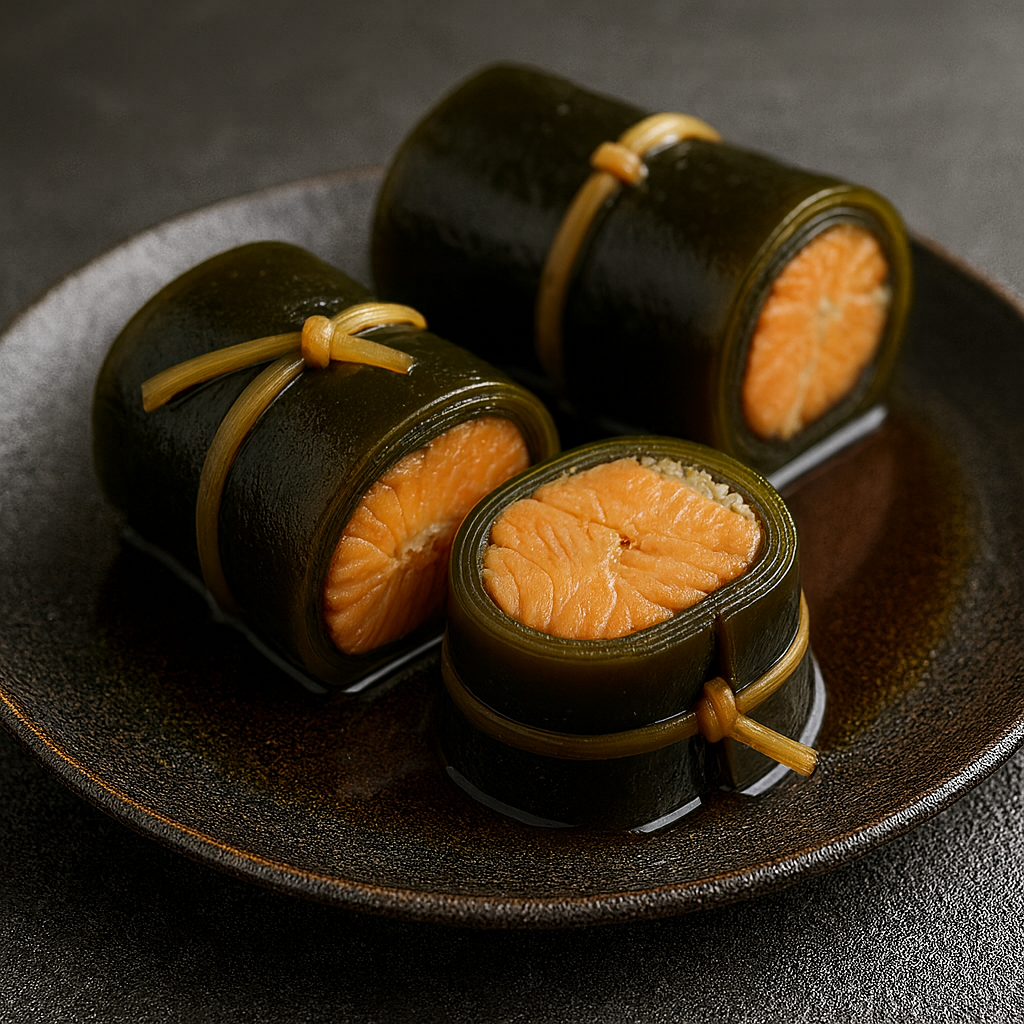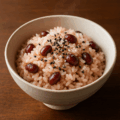鮭の昆布巻きの特徴
北海道のおせち料理や保存食
鮭の昆布巻きは、北海道を中心に親しまれる郷土料理で、鮭を昆布で巻き、甘辛く煮たものです。正月のおせち料理として定番で、保存食としても重宝されてきました。
昆布と鮭の旨味の調和
昆布の旨味と鮭の風味が合わさり、しっとりとした食感と奥深い味わいが楽しめます。かんぴょうで巻くことで形が整えられ、見た目にも美しい仕上がりになります。
縁起の良い料理
昆布は「喜ぶ」に通じる縁起物とされ、祝いの席やおせち料理に欠かせない一品です。
鮭の昆布巻きのレシピ
材料(4人分)
- 鮭(切り身) … 200g
- 昆布(長尺) … 2本(約30cm)
- かんぴょう … 適量
- 醤油 … 80ml
- みりん … 60ml
- 酒 … 60ml
- 砂糖 … 大さじ2
- だし汁 … 300ml
作り方
- 昆布は水で戻し、かんぴょうは塩でもんでから水で洗い、柔らかくしておく。
- 鮭を棒状に切り、昆布で巻き、かんぴょうで結んで固定する。
- 鍋にだし汁・醤油・みりん・酒・砂糖を入れて煮立て、昆布巻きを並べる。
- 落し蓋をして弱火で1〜1時間半ほど煮込み、味を含ませる。
シェフのワンポイントアドバイス
昆布は厚みのあるものを使うと煮崩れしにくく、しっかりとした食感に仕上がります。
煮込んだ後に一晩置くと味がさらに馴染み、美味しさが増します。
ニシンの昆布巻きも定番なので、置き換えても大丈夫です。
鮭の昆布巻きの栄養価(1人分の目安)
- エネルギー:約200〜250 kcal
- たんぱく質:15〜20 g
- 脂質:5〜8 g
- 炭水化物:15〜20 g(調味料由来)
- カルシウム・鉄分(昆布由来)
- ビタミンD・B群(鮭由来)
- 食物繊維(昆布由来)
魚のたんぱく質と昆布の食物繊維・ミネラルを一度に摂れる、栄養バランスの良い料理です。
鮭の昆布巻きの歴史
保存食としての役割
北海道の厳しい冬に備え、保存のきく昆布巻きは貴重な料理でした。鮭と昆布という北海道の特産を組み合わせた合理的な保存食です。
祝いの席に定着
「昆布=喜ぶ」の語呂合わせから、祝い事や正月のおせち料理に欠かせない一品となりました。
郷土料理から全国へ
現在では北海道だけでなく全国のおせち料理や和食店でも提供される、日本の伝統料理のひとつとして親しまれています。
English Version
Features of Salmon Kelp Roll (Sake no Kobumaki)
A Traditional New Year’s and Preserved Dish of Hokkaido
Salmon kelp roll, known as Sake no Kobumaki, is a traditional dish from Hokkaido in which salmon is wrapped in kelp and simmered in a sweet-savory sauce. It is a staple in New Year’s osechi cuisine and has long been valued as a preserved food.
Harmony of Salmon and Kelp
The umami of kelp blends with the rich flavor of salmon, creating a tender texture and deep taste. The rolls are tied with gourd strips (kanpyo), which keep their shape and enhance their presentation.
A Dish of Good Fortune
Kelp is associated with the word “yorokobu” (to rejoice) in Japanese, making it a symbol of good luck. For this reason, kobumaki is an essential item at celebratory occasions and New Year’s feasts.
Recipe
Ingredients (for 4 servings)
- Salmon (fillet) … 200 g
- Kelp (long sheets) … 2 pieces (about 30 cm each)
- Kanpyo (dried gourd strips) … as needed
- Soy sauce … 80 ml
- Mirin … 60 ml
- Sake … 60 ml
- Sugar … 2 tbsp
- Dashi broth … 300 ml
Instructions
- Soak the kelp in water until soft. Rub the kanpyo with salt, rinse, and soak until pliable.
- Cut the salmon into sticks, wrap each piece with kelp, and tie with kanpyo.
- Place dashi, soy sauce, mirin, sake, and sugar in a pot and bring to a boil. Add the rolls.
- Cover with a drop lid and simmer gently for 1 to 1.5 hours until the flavors are absorbed.
Chef’s Tip
Use thick kelp for a firmer texture and to prevent breakage during simmering. Letting the rolls rest overnight allows the flavors to blend more deeply. Herring kobumaki is also a classic alternative, and salmon can be replaced with it.
Nutritional Value (per serving, approx.)
- Calories: 200–250 kcal
- Protein: 15–20 g
- Fat: 5–8 g
- Carbohydrates: 15–20 g (from seasonings)
- Calcium & Iron (from kelp)
- Vitamin D & B group (from salmon)
- Dietary fiber (from kelp)
This dish provides a good balance of protein from fish and minerals and fiber from kelp, making it both nutritious and traditional.
Historical Background
A Preserved Food for Harsh Winters
In Hokkaido’s severe winters, kobumaki was valued as a preserved dish. Combining two regional specialties—salmon and kelp—made it a practical and flavorful food.
Adopted as a Celebratory Dish
Because “kombu” is a homophone for “yorokobu” (to rejoice), it became an auspicious food and a key part of New Year’s osechi meals.
From Regional Cuisine to National Tradition
Today, salmon kobumaki is not only a staple in Hokkaido but is also enjoyed across Japan, appearing in osechi cuisine and traditional Japanese restaurants nationwide.



何でも質問してください!